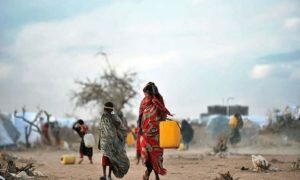 Paris, France | AFP | A massive truck bomb in the Somali capital of Mogadishu on Saturday killed at least 276 people and left 300 injured.
Paris, France | AFP | A massive truck bomb in the Somali capital of Mogadishu on Saturday killed at least 276 people and left 300 injured.
Following are five questions about the attack, the bloodiest in the country’s long history of violence and instability.
– What was the target? –
The bomb exploded at a junction in Hodan, a busy commercial district in northwestern Mogadishu that has many shops, hotels and other businesses.
But there was no notable government, military or other strategic target there.
For Matt Bryden, a Somalia specialist with Nairobi-based thinktank Sahan, “it’s not sure” the K5 intersection was the intended target.
Separately, a regional security source, who requested anonymity, speculated the truck may have been prepared for another operation that went wrong. A classic scenario is a two-bomb mission in which a first vehicle destroys the security around a protected target, and a second vehicle drives through the wrecked perimeter before blowing up.
The two sources said the truck bomb also blew up a nearby fuel tanker, which made the toll even greater. AFP did not see the remains of any fuel tanker at the junction, although the place is often used by fuel hawkers.
If the fuel truck was there, “was it pre-positioned or was it just coincidence?”, asked Bryden.
– What was the bomb? –
The security source estimated the bomb at between 500 kilogrammes (1,100 pounds) and two tonnes, which at the top end would be about the same scale as the device used by Al-Qaeda in the 1998 truck bombing of the US embassy in Nairobi that left 213 dead.
Bryden notes that in previous attacks in Mogadishu, bombs have been estimated at between 800 kilos and a tonne — but the damage they inflict was far less than on Saturday, when windows were shattered nearly a kilometre (more than half a mile) away.
Together with reports from the scene, this suggests the bomb was a mix of homemade and military explosives, said Bryden, pointing out that Somalia’s Al-Qaeda-linked group Shabaab “can’t make charges this big without homemade explosives.”
– What about security? –
The blast is a clear setback for the Somali security forces, which failed to “identify this (operation) and disrupt it” and ensure security at key access points in the city, said Bryden.
Somalia’s notorious Shabaab have a long record of being able to bypass checkpoints in Mogadishu, infiltrating the armed forces and moving around disguised in military uniforms.
Preparing and assembling a bomb on this scale is “a pretty complex and relatively long-term operation,” said Bryden.
– Why no claim? –
The two specialists independently agreed that the Shabaab were behind the attack, contending this is the only group in Somalia to have the resources to mount an operation of this size.
They also noted that in the past the jihadists have kept their lips sealed whenever an attack inflicted a civilian toll that triggered intense public anger. Similar silence followed a bomb attack at a hotel in 2009 where students were receiving their diplomas at a ceremony — 23 people died.
– What’s the aftermath? –
The first reaction has been anger. On Sunday, protests in the street highlighted the public’s fury at the Shabaab — although, noted Bryden, discontent may also turn on the government for failing to prevent the blast.
Beyond the public mood, though, the strategic situation is deadlocked.
“The Shabaab has lost some important leaders to raids and airstrikes over the last year. But they are very good at replenishing leadership. This operation demonstrates that they retain this capability to plan and carry out large-scale attacks,” Bryden said.
“They are not losing territory at the moment. There is very little movement on the ground. On the surface at least, what we see is stagnation.”


 Video24 hours ago
Video24 hours ago
 Somali News1 day ago
Somali News1 day ago
 Somali News1 day ago
Somali News1 day ago
 Somali News1 day ago
Somali News1 day ago
 Briefing Room2 days ago
Briefing Room2 days ago
 Somali News1 day ago
Somali News1 day ago
 Somaliland1 day ago
Somaliland1 day ago
 Diaspora8 hours ago
Diaspora8 hours ago
 Paris, France | AFP | A massive truck bomb in the Somali capital of Mogadishu on Saturday killed at least 276 people and left 300 injured.
Paris, France | AFP | A massive truck bomb in the Somali capital of Mogadishu on Saturday killed at least 276 people and left 300 injured.













 Mogadishu, 11 November 2017 – Today the Federal Government of Somalia, the United Nations Assistance Mission in Somalia and the African Union Mission in Somalia (AMISOM) held a joint meeting to discuss a comprehensive approach to security for the country.
Mogadishu, 11 November 2017 – Today the Federal Government of Somalia, the United Nations Assistance Mission in Somalia and the African Union Mission in Somalia (AMISOM) held a joint meeting to discuss a comprehensive approach to security for the country.
 The U.S. military said it killed “several militants” while conducting an airstrike in Somalia on Thursday against al-Qaeda-affiliated terrorist group al Shabab.
The U.S. military said it killed “several militants” while conducting an airstrike in Somalia on Thursday against al-Qaeda-affiliated terrorist group al Shabab.
 An Islamic State faction in Somalia has grown significantly over the past year, carrying out attacks in Puntland and receiving some funding from Syria and Iraq, a report by UN sanctions monitors said Friday.
An Islamic State faction in Somalia has grown significantly over the past year, carrying out attacks in Puntland and receiving some funding from Syria and Iraq, a report by UN sanctions monitors said Friday.














You must be logged in to post a comment Login